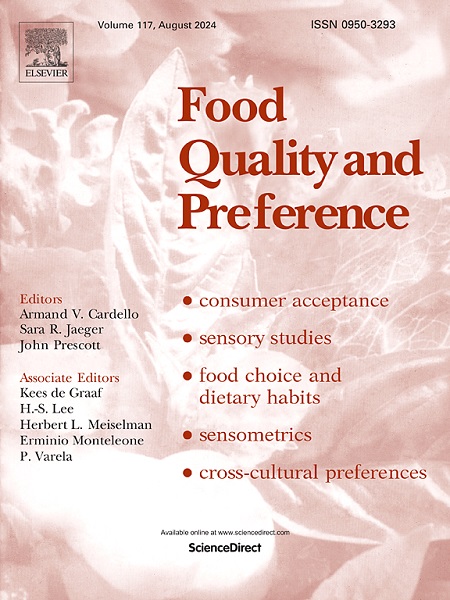这个辣吗?影响美国老年人选择辛辣食物的因素调查
IF 4.9
1区 农林科学
Q1 FOOD SCIENCE & TECHNOLOGY
引用次数: 0
摘要
在老年人的饮食中加入辛辣化合物可以促进这一不断增长的人口的兴趣、食欲和健康益处。这项研究的目的是增加美国老年人对“辣”概念的理解,考虑到影响辛辣食物偏好的因素。受访者(n = 656;平均年龄为65.7岁)完成了一项包含70个问题的在线调查,其中包括一些特定的问题。总体而言,受访者喜欢辛辣食物,对辛辣的偏好和消费量适中(平均2-3次/周)。在定义食物中的“辛辣”时,受访者使用了诸如热、烧、胡椒等术语;生姜也被认为对健康有益。辛辣食物摄入量的增加与对辛辣的喜爱和偏好的增加有关(p <;0.0001)。那些更喜欢辛辣的受访者不太可能报告在食用辛辣食物时感受到的热和刺痛的生理感觉,而那些感受到更多灼烧、刺痛、刺痛和鼻腔刺激的受访者对辛辣的偏好较低(p <;0.01)。喜欢辛辣食物的受访者具有冒险(39.3%)和满意(29.7%)的积极情绪(p <;0.0001),而不喜欢辛辣食物的受访者则表示更多的负面情绪,包括担心和狂野(13.3%;p & lt;0.001)。对辛辣食物的喜爱和对辛辣食物的偏好与旅行频率和烹饪偏好呈正相关。本研究结果表明,老年人的感官知觉、情绪、心理社会因素与辛辣食物偏好之间存在相互作用。本文章由计算机程序翻译,如有差异,请以英文原文为准。
Is this spicy? Investigation of factors that influence spicy food choices by US older adults
The inclusion of spicy compounds in the older adult diet can promote interest, appetite and health benefits of this growing population. The objective of this study was to increase the understanding of the concept of “spicy” by US older adults, considering factors that influence spicy food preferences. Respondents (n = 656; average age = 65.7) completed an online survey of 70 questions including spicy-specific questions. In general, respondents enjoyed spicy foods, with moderate spicy preference and spicy consumption (2-3×/week on average). When defining “spicy” in foods, respondents used terms such as hot, burn, pepper; ginger was also used as being associated with health benefits. An increased consumption of spicy foods was associated with higher spicy liking and spicy preferences (p < 0.0001). Respondents who had higher spicy liking were less likely to report hot and tingling as physiological sensations perceived during consumption of spicy foods while respondents who perceived more burning, stinging, prickling and nasal irritation sensations had lower spicy preference (p < 0.01). Respondents who liked spicy foods had associated positive emotions of adventurous (39.3 %) and satisfied (29.7 %) (p < 0.0001) while respondents who did not like spicy foods cited more negative emotions, including worried and wild (13.3 %; p < 0.001). Liking of spicy foods and spicy preferences was positively related to frequency of travel and cuisine preference. The results of this study demonstrate the interplay between sensory perceptions, emotions, psychosocial factors and spicy food preferences in older adults.
求助全文
通过发布文献求助,成功后即可免费获取论文全文。
去求助
来源期刊

Food Quality and Preference
工程技术-食品科技
CiteScore
10.40
自引率
15.10%
发文量
263
审稿时长
38 days
期刊介绍:
Food Quality and Preference is a journal devoted to sensory, consumer and behavioural research in food and non-food products. It publishes original research, critical reviews, and short communications in sensory and consumer science, and sensometrics. In addition, the journal publishes special invited issues on important timely topics and from relevant conferences. These are aimed at bridging the gap between research and application, bringing together authors and readers in consumer and market research, sensory science, sensometrics and sensory evaluation, nutrition and food choice, as well as food research, product development and sensory quality assurance. Submissions to Food Quality and Preference are limited to papers that include some form of human measurement; papers that are limited to physical/chemical measures or the routine application of sensory, consumer or econometric analysis will not be considered unless they specifically make a novel scientific contribution in line with the journal''s coverage as outlined below.
 求助内容:
求助内容: 应助结果提醒方式:
应助结果提醒方式:


